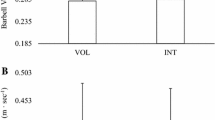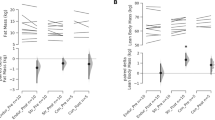Summary
Changes in strength, body composition and anthropometric measures for groups training with constant resistance and variable resistance training procedures was compared. Thirty-six male volunteers were randomly assigned to one of three groups: Constant Resistance (CR), Variable Resistance (VR) and Control (C). Strength training was conducted 3 days per week, 45 min per day, for 10 weeks. The results demonstrated that both the CR and the VR groups increased muscular strength. The CR group demonstrated significant increases in strength over the VR group when strength was assessed by CR procedures. Conversely, the VR group demonstrated significant increases in strength over the CR group when strength was assessed by VR procedures. Neither group exhibited superiority over the other relative to changes in body composition and anthropometric measures. The significance of these results is discussed.
Similar content being viewed by others
References
Berger, R. A.: Effect of varied weight training programs on strength. Res. Quart. Amer. Hlth phys. Educ. 33, 168–181 (1962)
Berger, R. A.: Comparison between resistance load and strength improvement. Res. Quart. Amer. Hlth phys. Educ. 33, 637 (1962)
Berger, R. A.: Comparison of static and dynamic strength increases. Res. Quart. Amer. Hlth phys. Educ. 33, 329–333 (1962)
Berger, R. A.: Comparison of the effect of various weight training loads on strength. Res. Quart. Amer. Hlth phys. Educ. 33, 141–146 (1965)
Capen, E. K.: The effect of systematic weight training on power, strength and endurance. Res. Quart. Amer. Hlth phys. Educ. 21, 83–93 (1950)
Chui, E.: The effect of systematic weight training on athletic power. Res. Quart. Amer. Hlth phys. Educ. 21, 188–194 (1950)
Clarke, D. H.: Adaptations in strength and muscular endurance resulting from exercise. Vol. 1. Exercise and sports sciences reviews (J. H. Wilmore, ed.). New York: Academic Press 1973
Fahey, T. D., Brown, C. H.: The effects of an anabolic steroid on the strength, body composition, and endurance of college males when accompanied by a weight training program. Med. Sci. Sports 5, 172–276 (1973)
O'Shea, P.: Effect of selected weight training programs on the development of strength and muscle hypertrophy. Res. Quart. Amer. Hlth phys. Educ. 37, 95–102 (1966)
Peterson, J. A.: Total conditioning: A case study. Athletic Journal 55, 40–55 (1975)
Pipes, T. V., Wilmore, J. H.: Isokinetic vs isotonic strength training in adult men. Med. Sci. Sports 7, 262–274 (1975)
Plese, E.: The Colorado experiment. Athletic Journal 53, 42–44 (1973)
Siri, W. E.: Body composition from fluid spaces and density. Univ. Cal. Donner Lab. Med. Physics Dept., March 19, 1956
Wilmore, J. H.: A simplified method for determination of residual lung volumes J. appl. Physiol. 27, 96–100 (1969)
Wilmore, J. H., Behnke, A. R.: An anthropometric estimation of body density and lean body weight in young men. J. appl. Physiol. 27, 25–31 (1969)
Author information
Authors and Affiliations
Rights and permissions
About this article
Cite this article
Pipes, T.V. Variable resistance versus constant resistance strength training in adult males. Europ. J. Appl. Physiol. 39, 27–35 (1978). https://doi.org/10.1007/BF00429676
Accepted:
Issue Date:
DOI: https://doi.org/10.1007/BF00429676




